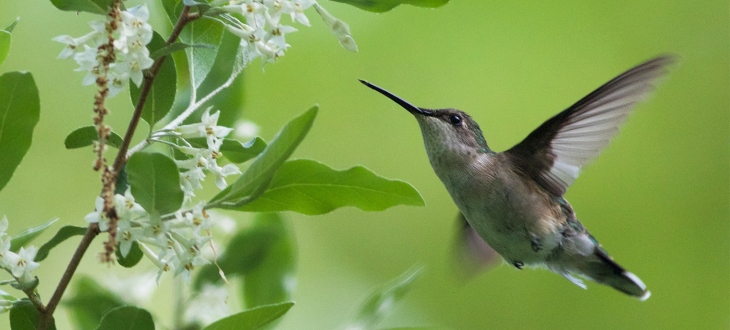The State We're In
Glittering jewels of the sky
This time of year, New Jersey is popping with color from blooming flowers and shrubs and beautiful songbirds.
One of the brightest is the ruby-throated hummingbird, which returns to the Garden State each spring to breed and raise young.
These tiny birds – weighing only a little more than a nickel – are the only hummingbirds native to New Jersey. They spend winters in Mexico and Central America and fly north in the spring to breed, the males arriving ahead of the females. Their arrival coincides with the emergence of insects and flowering wildflowers and shrubs.
Males have bright emerald-green feathers and an iridescent red throat patch that flashes in the sunlight. Females and juveniles don’t have the ruby throat patch, and their green coloring is more subdued.
The speed of the hummingbirds’ flight and their ability to hover make them fascinating to observe.
If you’re outside enjoying the fresh air and warm weather, you might first notice a hummingbird buzzing past in a blur, like a super-fast bumblebee. If you’re lucky, it might pause to sip nectar from a flower or perch on a slim tree branch. Newcomers to bird-watching should be sure not to confuse hummingbirds with day-flying clearwing sphinx moths, which look like little fuzzy flying lobsters and are also known as hummingbird moths.
In the spring, male hummingbirds put on acrobatic aerial displays to attract females. Their maneuvers include repeatedly soaring up to 100 feet in the air and plunging toward the ground.
After mating, male ruby-throats are pretty much out of the picture, as females nest and raise young on their own.
Female hummingbirds use nature’s original stretchy fiber – silk from spider webs – to bind dandelion and thistle down into a nest the size of a large thimble. Like jeans made of spandex, these nests stretch and expand as the hatchlings grow. It takes sharp eyes to spot hummingbird nests, as they’re built on tree branches 10-40 feet high and cleverly camouflaged with lichen and moss.
Hummingbirds can rapidly rotate their wings over 90 degrees at the shoulder socket. Every wing upstroke relies on back muscles equally as powerful as the breast muscles that power the downstroke. No beat of a wing is wasted simply “lifting” the wing back to a starting position as in typical birds. Hovering is actually flying straight up, balanced against the downward pull of gravity. If you could magically switch off the force of gravity the hummingbird would accelerate straight up like an Apollo rocket launch!
Because of their speed and agility, hummingbirds are bold and fearless. They’re highly territorial about food sources and will dive-bomb competitors for flowers and feeders. They’ve even been known to attack other species – including bald eagles, which weigh 1,600 times as much!
To fuel all that flying, hummingbirds sip sugary nectar from flowers using long, hollow tongues that work like soda straws. They’re critical pollinators for native plants with tubular flowers, and their high metabolism requires many times their body weight in nectar each day.
But hummingbirds also need protein. They “flycatch” mosquitoes and midges in mid-air, and pick spiders and caterpillars off leaves. Because of their protein requirements, they prefer to nest near wetlands and stream corridors where insects are plentiful.
It’s easy to attract ruby-throated hummingbirds to your backyard with brightly-colored flowers and nectar feeders. Plant flowers like trumpet vine, bee balm, lobelia, salvia, butterfly weed, petunia, hibiscus, mandevilla, morning glory and native coral honeysuckle; hummingbirds especially like plants with bright red, orange and pink blossoms. You’ll hear their distinctive chattering peeps as they zip from flower to flower.
Set up a feeder outside your window for maximum viewing pleasure. Most feeders are colored red to grab the hummingbirds’ attention, and some have tiny perches to entice visitors to stay longer.
Mixing hummingbird food is simple. Add a quarter-cup of table sugar to one cup of water, but leave out the food coloring because it could be harmful to the birds. Hang the feeder in a place that gets midday and afternoon shade. Clean the feeder and change the sugar water often, because it can ferment in summer heat. Also, take care not to place the feeder in a place where hummingbirds will be vulnerable to cats.
But don’t wait, because hummingbird season is short! By mid-August, most males will begin their southward migration, and females and juveniles will follow a few weeks later.
The ruby-throated hummingbird population has probably increased over the last 50 years due to the abandonment of farmlands, the overall increase in thickets and shrubby habitats, and the prevalence of feeders. However, dangerous agricultural insecticides pose a threat in certain localities.
If you’re really into hummingbird watching, share your observations. Each year, thousands of citizen scientists track migrations, which helps researchers determine whether patterns are shifting due to climate change or other factors.
One great site where you can report bird sightings is eBird, a project of the Cornell Lab of Ornithology – www.ebird.org. Another is www.hummingbirds.net, a website with constantly-updating maps showing the annual hummingbird migration.
For more information on identifying, observing and feeding hummingbirds, visit the Cornell Lab of Ornithology website at www.allaboutbirds.org/guide/ruby-throated_hummingbird/id.
And to learn more about preserving New Jersey’s land and natural resources, visit New Jersey Conservation Foundation’s website at www.njconservation.org or contact me at info@njconservation.org.
About the Authors
Alison Mitchell
Co-Executive Director
John S. Watson, Jr.
Co-Executive Director
Tom Gilbert
Co-Executive Director, 2022-2023
Michele S. Byers
Executive Director, 1999-2021
View their full bios here.
Filter
Get The Latest News
From The Garden State
In the
News

